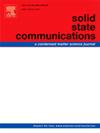Excellent thermoelectric properties of mono and multilayers dichalcogenide MoS2 with mechanical deformation, A first principles calculations
IF 2.1
4区 物理与天体物理
Q3 PHYSICS, CONDENSED MATTER
引用次数: 0
Abstract
We investigated the thermoelectric properties of bulk, monolayer and multilayers MoS2 by a first principles calculations with semi-classical Boltzmann transport theory. This material is a semiconductor with direct band gap of about 1.33eV and has thermoelectric properties. Trilayer MoS2 has a good thermoelectric performance, viz. optimal electronic figure of merit of 0.69 and power factor of 10.37 mW/K2 m at 700K. Mechanical deformation may reduce lattice thermal conductivity and furthermore increase figure of merit of MoS2. So we also investigated the effect of mechanical deformation on the thermoelectric properties of MoS2 by a first principles calculations and Boltzmann transport theory. Almost mechanical deformations reduced the thermoelectric performance of 2D MoS2 systems, but the deformation for monolayer MoS2 enhanced its thermoelectric performance. In the case of monolayer MoS2 with deformation of −2 %, optimal power factor was 18.44 mW/K2 m and total figure of merit was 0.55 at 700K.
具有机械变形的单层和多层二硫化钼的优异热电性能,A第一性原理计算
利用半经典玻尔兹曼输运理论的第一性原理计算,研究了大块、单层和多层二硫化钼的热电性质。该材料为半导体,直接带隙约为1.33eV,具有热电性质。三层二硫化钼具有良好的热电性能,700K时最优电子优值为0.69,功率因数为10.37 mW/K2 m。机械变形可以降低二硫化钼的晶格导热系数,进而提高其性能系数。因此,我们还通过第一性原理计算和玻尔兹曼输运理论研究了机械变形对二硫化钼热电性能的影响。几乎机械变形降低了二维二硫化钼的热电性能,而单层二硫化钼的变形提高了其热电性能。对于变形量为- 2%的MoS2单层材料,700K时的最佳功率因数为18.44 mW/K2 m,总优值为0.55。
本文章由计算机程序翻译,如有差异,请以英文原文为准。
求助全文
约1分钟内获得全文
求助全文
来源期刊

Solid State Communications
物理-物理:凝聚态物理
CiteScore
3.40
自引率
4.80%
发文量
287
审稿时长
51 days
期刊介绍:
Solid State Communications is an international medium for the publication of short communications and original research articles on significant developments in condensed matter science, giving scientists immediate access to important, recently completed work. The journal publishes original experimental and theoretical research on the physical and chemical properties of solids and other condensed systems and also on their preparation. The submission of manuscripts reporting research on the basic physics of materials science and devices, as well as of state-of-the-art microstructures and nanostructures, is encouraged.
A coherent quantitative treatment emphasizing new physics is expected rather than a simple accumulation of experimental data. Consistent with these aims, the short communications should be kept concise and short, usually not longer than six printed pages. The number of figures and tables should also be kept to a minimum. Solid State Communications now also welcomes original research articles without length restrictions.
The Fast-Track section of Solid State Communications is the venue for very rapid publication of short communications on significant developments in condensed matter science. The goal is to offer the broad condensed matter community quick and immediate access to publish recently completed papers in research areas that are rapidly evolving and in which there are developments with great potential impact.
 求助内容:
求助内容: 应助结果提醒方式:
应助结果提醒方式:


